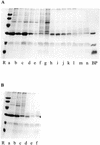The abundant class III chitinase homolog in young developing banana fruits behaves as a transient vegetative storage protein and most probably serves as an important supply of amino acids for the synthesis of ripening-associated proteins
- PMID: 12376669
- PMCID: PMC166631
- DOI: 10.1104/pp.006551
The abundant class III chitinase homolog in young developing banana fruits behaves as a transient vegetative storage protein and most probably serves as an important supply of amino acids for the synthesis of ripening-associated proteins
Abstract
Analyses of the protein content and composition revealed dramatic changes in gene expression during in situ banana (Musa spp.) fruit formation/ripening. The total banana protein content rapidly increases during the first 60 to 70 d, but remains constant for the rest of fruit formation/ripening. During the phase of rapid protein accumulation, an inactive homolog of class III chitinases accounts for up to 40% (w/v) of the total protein. Concomitant with the arrest of net protein accumulation, the chitinase-related protein (CRP) progressively decreases and several novel proteins appear in the electropherograms. Hence, CRP behaves as a fruit-specific vegetative storage protein that accumulates during early fruit formation and serves as a source of amino acids for the synthesis of ripening-associated proteins. Analyses of individual proteins revealed that a thaumatin-like protein, a beta-1,3-glucanase, a class I chitinase, and a mannose-binding lectin are the most abundant ripening-associated proteins. Because during the ripening of prematurely harvested bananas, similar changes take place as in the in situ ripening bananas, CRP present in immature fruits is a sufficient source of amino acids for a quasi-normal synthesis of ripening-associated proteins. However, it is evident that the conversion of CRP in ripening-associated proteins takes place at an accelerated rate, especially when climacteric ripening is induced by ethylene. The present report also includes a discussion of the accumulation of the major banana allergens and the identification of suitable promoters for the production of vaccines in transgenic bananas.
Figures





Similar articles
-
Banana MaSPL16 Modulates Carotenoid Biosynthesis during Fruit Ripening through Activating the Transcription of Lycopene β-Cyclase Genes.J Agric Food Chem. 2020 Feb 5;68(5):1286-1296. doi: 10.1021/acs.jafc.9b07134. Epub 2020 Jan 24. J Agric Food Chem. 2020. PMID: 31891496
-
A ripening-induced transcription factor MaBSD1 interacts with promoters of MaEXP1/2 from banana fruit.Plant Cell Rep. 2014 Nov;33(11):1913-20. doi: 10.1007/s00299-014-1668-6. Epub 2014 Aug 6. Plant Cell Rep. 2014. PMID: 25097074
-
Transcriptome analysis of ripe and unripe fruit tissue of banana identifies major metabolic networks involved in fruit ripening process.BMC Plant Biol. 2014 Dec 2;14:316. doi: 10.1186/s12870-014-0316-1. BMC Plant Biol. 2014. PMID: 25442405 Free PMC article.
-
Bananas--physiology and biochemistry of storage and ripening for optimum quality.Crit Rev Food Sci Nutr. 1980;13(1):41-88. doi: 10.1080/10408398009527284. Crit Rev Food Sci Nutr. 1980. PMID: 6996924 Review.
-
The Starch Is (Not) Just Another Brick in the Wall: The Primary Metabolism of Sugars During Banana Ripening.Front Plant Sci. 2019 Apr 2;10:391. doi: 10.3389/fpls.2019.00391. eCollection 2019. Front Plant Sci. 2019. PMID: 31001305 Free PMC article. Review.
Cited by
-
Crystallization and preliminary X-ray diffraction analysis of a new chitin-binding protein from Parkia platycephala seeds.Acta Crystallogr Sect F Struct Biol Cryst Commun. 2005 Sep 1;61(Pt 9):841-3. doi: 10.1107/S1744309105024462. Epub 2005 Aug 31. Acta Crystallogr Sect F Struct Biol Cryst Commun. 2005. PMID: 16511174 Free PMC article.
-
Deep sequencing of the Mexican avocado transcriptome, an ancient angiosperm with a high content of fatty acids.BMC Genomics. 2015 Aug 13;16(1):599. doi: 10.1186/s12864-015-1775-y. BMC Genomics. 2015. PMID: 26268848 Free PMC article.
-
A novel family of lectins evolutionarily related to class V chitinases: an example of neofunctionalization in legumes.Plant Physiol. 2007 Jun;144(2):662-72. doi: 10.1104/pp.106.087981. Epub 2006 Nov 10. Plant Physiol. 2007. PMID: 17098856 Free PMC article.
-
Promoter activation of pepper class II basic chitinase gene, CAChi2, and enhanced bacterial disease resistance and osmotic stress tolerance in the CAChi2-overexpressing Arabidopsis.Planta. 2006 Feb;223(3):433-48. doi: 10.1007/s00425-005-0099-6. Epub 2005 Sep 6. Planta. 2006. PMID: 16151843
-
Pyramiding transgenic resistance in elite indica rice cultivars against the sheath blight and bacterial blight.Plant Cell Rep. 2007 Jun;26(6):791-804. doi: 10.1007/s00299-006-0292-5. Epub 2007 Jan 13. Plant Cell Rep. 2007. PMID: 17221225
References
-
- Barre A, Peumans WJ, Menu-Bouaouiche L, Van Damme EJM, May GD, Fernandez Herrera A, Van Leuven F, Rougé P. Purification and structural analysis of an abundant thaumatin-like protein from ripe banana fruit. Planta. 2000;211:791–799. - PubMed
-
- Blanco C, Diaz-Perales A, Collada C, Sanchez-Monge R, Aragoncillo C, Castillo R, Ortega N, Alvarez M, Carrillo T, Salcedo G. Class I chitinases as potential panallergens involved in the latex-fruit syndrome. J Allergy Clin Immunol. 1999;103:507–513. - PubMed
-
- Bleecker AB, Kende H. Ethylene: a gaseous signal molecule in plants. Annu Rev Cell Dev Biol. 2000;16:1–18. - PubMed
-
- Breiteneder H, Ebner C. Molecular and biochemical classification of plant-derived food allergens. J Allergy Clin Immunol. 2000;106:27–36. - PubMed
-
- Breiteneder H, Scheiner O. Molecular and immunological characteristics of latex allergens. Int Arch Allergy Immunol. 1998;116:83–92. - PubMed
Publication types
MeSH terms
Substances
LinkOut - more resources
Full Text Sources
Research Materials
Miscellaneous

